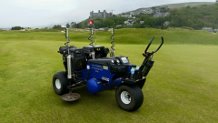Hi all,
Apologies for the gap in between blogs, now i will tend to get as much information as i can out there via our Facebook page at Royal St Davids Links Team, this from my angle is far quicker as i try and spend all my time on the golf course getting as much work done out there as possible that will improve the links even further.
Unfortunately another wet spell has hit us,course is holding up well but bunkers are very wet due to the high water table,we have had 149mm in June with the average being 73mm, 119 with the average being 76mm in July, 103 mm in August with the average being 95,September we had 193 with the average being 96mm, and already up at 51mm and counting for October and a total so far this year being 940mm.
Lets pray for some dry weather!
The addition of ilan Hughes as an apprentice greenkeeper has been of great value to the team giving us the additional resources to hand cut and it has certainly made a difference.
We have been working hard on improving the botanical content of the finer grasses in the greens and have overseeded 8 times this year, im delighted with this and there is without question an improvement in the percentage of finer grasses within the sward, this will give better playing qualities, better disease resistance and more sustainable golf greens.
Our aeration has again this year been good with monthly pro core aeration and we have just started vertidrained last week and we will again now before christmas and will be slitting weekly until christmas as well as other forms of aeration. The aim is to keep the greens as dry as possible to aid the finer grasses and their development.
Also the penal rough is also to be managed more which will enable the course to be more playable and less time looking for golf balls.
The Amazon flail mower cutting and collecting the roughs.
The vredo Overseeder in action
We have had some damage on some holes from chafer grubs and all things associated with this grub, now with the chemical withdrawl of Merit Turf (imidacloprid) there is no chemical control to tackle these, a few people try nematodes but their efficacy is questionable and getting them into the ground and into the grub is also difficult as well as being extremely expensive.
We have been applying iron at a high rate to try and deter and badger activity and this seems to of worked well.
Chafer grubs are the larvae of the Chafer Beetle. There are six species in the UK: the Welsh Chafer, Summer Chafer, Brown Chafer, Cock Chafer, Garden Chafer and Rose Chafer. The most familiar being the Cock Chafer or "May bug" a large beetle that can be heard as a low droning noise on pleasant spring evenings. Though commonly the main problems on lawns are caused by just two species: the Garden Chafer and the Welsh Chafer. The grubs feed on the roots of grasses and other plants, their presence can be detected by the yellowing patches that it creates in turf. Chafer grubs can be found in the soil under the loose turf. They live within the soil for up to 3-4 years going through various "instars" as they develop. Significant damage to turf can be done by predators such as starlings, rooks, crows, jackdaws, magpies, foxes and badgers that make the most of an abundant high protein feed lying just beneath the surface.
They have stout white bodies curved in a C shape, light brown heads, with three pairs of legs and darker patches at the base of the abdomen. They are bigger than the adult beetles although their size varies according to species, 8-35mm; typically the Garden Chafer and Welsh Chafer are between 10mm and 15mm long. The head and thorax are metallic blue-green on the Garden Chafer and black on the Welsh Chafer. The grubs eat the roots and damage and eventually kill the plant. The first symptoms are yellowing patches that eventually turn brown, particularly in dry weather. These areas are then pecked at or dug up by predators. In severe infestations the turf can be pulled back to reveal as many as 100 grubs per square metre.
The Links Team will be starting on the winter work programme very soon with the aim of trying to improve the condition and playability of the links top priorities.
Regards
Rhys Butler, Links Manager, Royal St David's Golf Club.






































